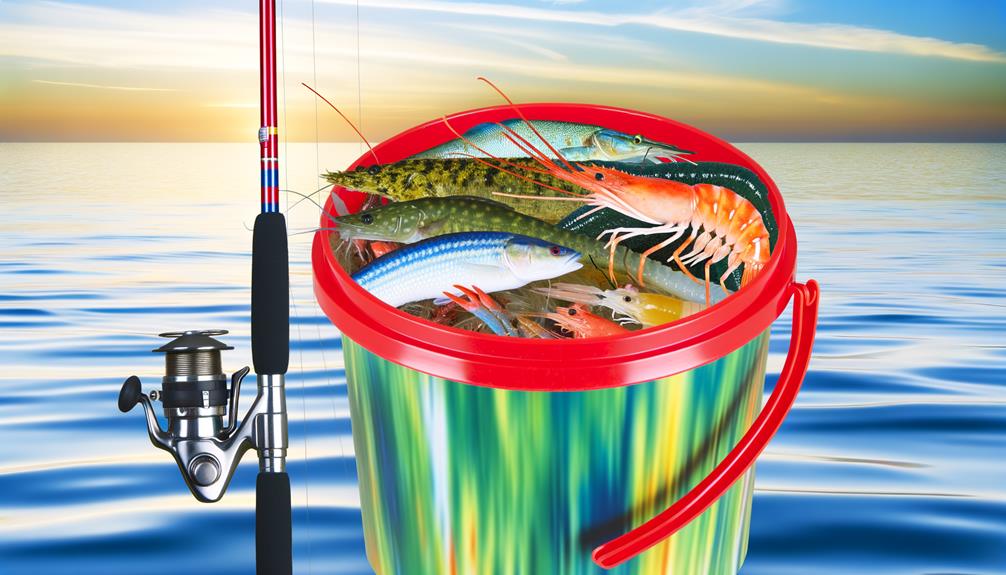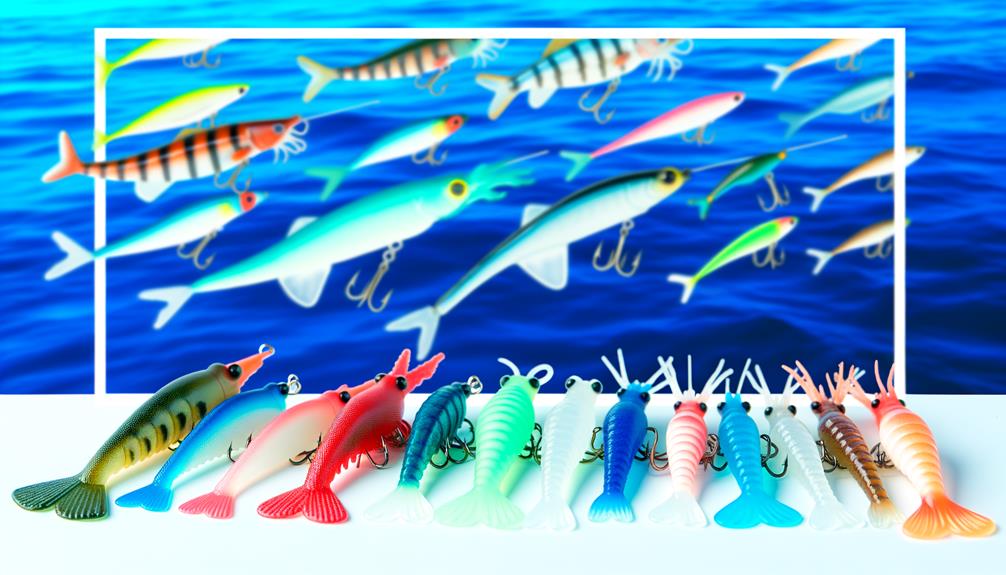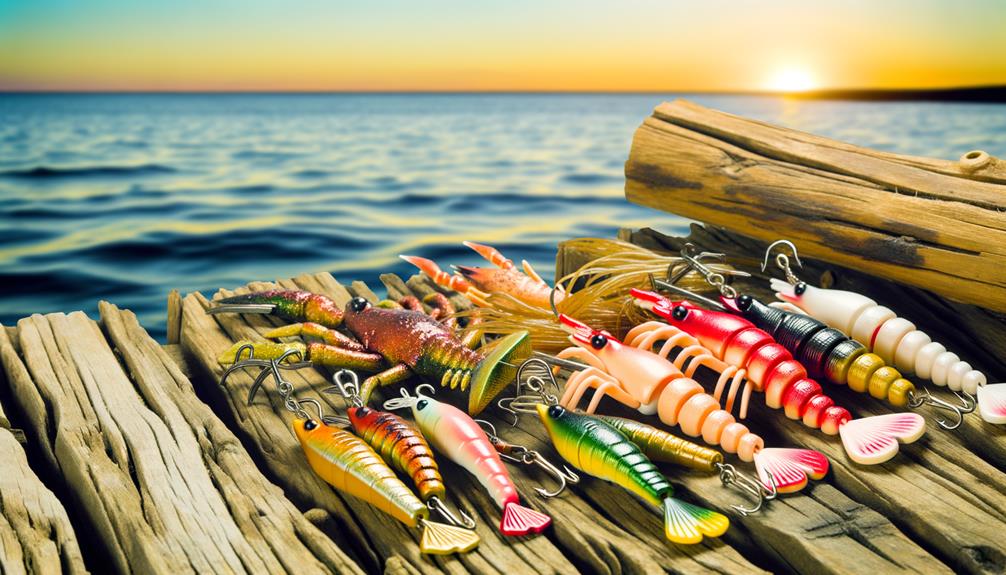The selection of bait for saltwater fishing is an intricate process that requires a comprehensive understanding of marine life and their feeding habits. The choice between a shrimp, a shellfish, a cut bait, or a bait fish does not only depend on the type of fish you aim to catch, but also on the local ecological conditions and fishery regulations.
In order to enhance your fishing strategy, it is pertinent to explore this topic further and learn how to efficiently match the bait to the specific fish species and local environmental factors.
Key Takeaways
- Live shrimp, baitfish, crabs, and shellfish are among the top live baits for a successful saltwater fishing trip.
- The size and diet of the target fish heavily influence bait choice for effective saltwater fishing.
- Artificial baits, offering durability and cost-effectiveness, can also be a good choice depending on the conditions and preferences.
- Cut bait and baitfish like mullet are ideal for attracting predatory fish species in saltwater fishing.
Understanding Saltwater Bait Essentials
In the realm of saltwater fishing, understanding the essentials of bait selection is fundamental. Choices range from versatile shrimp, attractive shellfish like clams, mussels, and crabs, to strongly aromatic cut bait and bait fish, such as eels and pilchards, each offering distinct advantages based on target fish size, species preferences, and natural diet.
Live shrimp, due to its scent and movement, is an effective bait that appeals to a wide variety of fish species. Its versatility makes it a staple in the bait boxes of many anglers. Similarly, shellfish, with their distinctive textures and flavors, attract certain types of fish such as grouper, making them a valuable addition to the angler's arsenal.
Cut bait, derived from bait fish, emits a potent aroma that is irresistible to species like sea bass and mahi mahi. Its strong scent profile makes it a powerful tool for attracting saltwater game fish. On the other hand, bait fish like eels and pilchards replicate the natural movement and scent of prey, making them an optimal choice for mimicking the natural diet of many fish species. Choosing the right bait, therefore, involves a detailed understanding of these essentials.
Factors Influencing Bait Choice
While understanding the essentials of bait is key, the selection process is significantly influenced by several factors, including the size and diet of the target fish species. The size of the bait should correspond to the size of the fish you intend to catch. If the bait is too large, it may intimidate smaller fish, reducing your chances of a successful catch. Conversely, bait that is too small may not attract larger fish.
The diet of the fish species is another vital element when choosing your bait. Matching the bait to the fish's natural diet increases the effectiveness of your fishing. For instance, some species prefer crustaceans such as shrimp, while others are more attracted to baitfish like mullet. Live bait, such as live shrimp, can be universally attractive to a broad range of ocean fish species due to its vitality and natural movement.
Catching your bait can be a cost-effective alternative to purchasing it, providing an added layer of authenticity and attractiveness to the fish. It's crucial to remember that the attractiveness of the bait to the fish is key in improving your chances of a successful saltwater fishing experience.
Top Live Baits for Saltwater Fishing

Selecting the appropriate live bait is a crucial aspect of successful saltwater fishing, with options ranging from versatile live shrimp to various baitfish such as eels, ballyhoo, and pilchards. Each of these choices offers its unique advantages, catering to specific angling strategies and target species.
Live shrimp, with their natural scent and movement, are attractive to a broad range of saltwater fish species, making them a versatile choice for novice and experienced anglers alike. Baitfish like eels, ballyhoo, and pilchards are not only effective in attracting game fish but also in mimicking their natural prey, resulting in a higher success rate.
Crabs, another option for live bait, are ideal for targeting crustacean-eating fish. Their hardy nature allows them to be kept alive for several days, providing extended fishing opportunities. Similarly, shellfish such as clams and mussels serve as effective baits for species like grouper, owing to their rich scent profile and familiar texture.
Selecting the Right Bait for You
When selecting the optimal bait for saltwater fishing, it is crucial to comprehend the dietary habits of your target species.
The decision between live and artificial bait can greatly influence your fishing success, with each offering distinct advantages in different scenarios.
The choice of bait not only affects the species of fish you attract but also plays a significant role in the overall success of your fishing expedition.
Understanding Saltwater Fish Diet
Given the diversity in the diets of saltwater fish – encompassing a range from crustaceans to bait fish and other marine life – it is essential to match your bait choice to the natural feeding habits of the species you're targeting to increase the likelihood of a successful catch.
For instance, live shrimp serve as a universal bait for saltwater fishing lures due to their wide appeal to a range of saltwater fish. Understanding what fish eat, particularly the species you are targeting, allows you to select the most effective live baits.
Ultimately, your bait selection contributes significantly to enticing saltwater fish, thereby enhancing your overall fishing experience and fostering a sense of belonging within the angling community.
Live Vs Artificial Bait
In the realm of saltwater fishing, the choice between live and artificial bait hinges on a myriad of factors, including target species, fishing conditions, and angler preferences, each offering distinct advantages and limitations. Live bait, with its natural movement and scent, appeals to a broad spectrum of saltwater fish species. This is often the go-to for novice anglers due to its higher success rate.
On the other hand, artificial bait offers versatility. Crafted to mimic natural prey, it provides:
- Durability in various saltwater conditions
- A wide range of designs to target specific species
- Reusability, making it a cost-effective option
Ultimately, the choice between live and artificial bait is personal, influenced by your target species, fishing conditions, and individual preferences.
Saltwater Lures and Baits Breakdown

Delving into the intricacies of saltwater lures and baits, one must comprehend the appeal and effectiveness of various options such as shrimp, shellfish, cut bait, and bait fish, each of which is proven to significantly enhance the success rate in saltwater fishing. The best fishing results often come from a deep understanding of the types of saltwater prey that your target species feed on.
Live shrimp, for instance, are a universal choice due to their wide appeal to a range of fish species. Shellfish, on the other hand, are excellent for species that feed on crustaceans. Cut bait, consisting of pieces of fish, is ideal for predator species, while bait fish, like mullet or sardines, are a staple in the diet of numerous saltwater fish.
Artificial saltwater lures offer a versatile alternative. Jigging lures, topwater lures, and soft plastic lures mimic the movement and appearance of natural prey, enticing fish to bite. The choice of lure or bait should consider targeted fish species, water conditions, and time of day. Therefore, a strategic selection of saltwater lures and baits can significantly increase the chances of a successful catch.
Bait Vs Lures: What's the Difference?
In the realm of saltwater fishing, the distinction between bait and lures is critical, each offering unique advantages and drawbacks.
Bait, utilizing natural substances such as shrimp or shellfish, aims to attract fish through scent and movement, however, it is perishable and needs frequent replacement.
Conversely, lures, by mimicking the appearance and movement of prey, stimulate a fish's predatory instincts, and though requiring more skill to employ effectively, they offer the benefits of durability and adaptability to various water conditions and depths.
Understanding Bait and Lures
Understanding the crucial differences between bait and lures is fundamental to successful saltwater fishing, as each has unique characteristics and applications tailored to specific fishing conditions and species.
Bait, typically organic material like shrimp or cut bait, lures fish with scent and taste, and is often used specifically to catch saltwater species or for bottom fishing. On the other hand, the best lures mimic the appearance and motion of prey, triggering strikes through visual appeal and action.
In summary:
- Bait can attract smaller fish using natural scents and tastes, but requires constant replacement.
- Lures, made of various materials and shapes, can be reused and customized.
- While bait targets specific species, lures offer versatility for different fishing techniques.
Choosing Bait Vs Lures
When it comes to selecting between bait and lures for saltwater fishing, the decision hinges on several factors including the target species, the specific fishing conditions, and the skill level of the angler. Bait is natural and attracts fish through scent and movement, while lures are artificial and trigger strikes due to their design and presentation.
Here's a comparison for reference:
| Bait | Lures |
|---|---|
| Natural, live | Artificial |
| Attracts wide range of species | Mimics specific prey |
| Requires less skill | Requires technique and skill |
| Can be less versatile | High versatility |
| Directly appeals to fish senses | Triggers predatory instincts |
Ultimately, the choice between bait and lures depends on the fishing scenario and angler preference, ensuring an inclusive fishing experience for all.
Essential Saltwater Fishing Lures

Essential saltwater fishing lures, such as jigging lures, topwater lures, spoon lures, soft plastic lures, and plug lures, are designed to entice a variety of marine species by mimicking prey movements, creating surface disturbances, producing underwater vibrations, offering versatile rigging options, and imitating injured baitfish respectively.
For inshore fishing, these lures can be particularly effective. Topwater lures, for instance, produce surface disturbances that can attract aggressive predator fish. This lure can provide thrilling action as you witness the attack on the water's surface.
Soft plastic lures are another versatile choice. These can be rigged in various ways, making them adaptable to different fishing conditions and species. With their lifelike movements, they can tempt a wide range of saltwater fish.
Understanding the unique characteristics and applications of each lure can greatly enhance your saltwater fishing experience. Here are some key takeaways:
- Jigging lures are great for mimicking prey movements.
- Topwater lures attract predator fish by creating surface disturbances.
- Soft plastic lures offer versatile rigging options and can imitate injured baitfish.
Embrace the joy of belonging to the fishing community by mastering these essential lures.
Frequently Asked Questions
What Is the Best Bait to Catch Saltwater Fish?
The best bait for saltwater fishing varies seasonally and includes shrimp, shellfish, and cut bait. Optimal bait selection involves preservation techniques, sustainability considerations, and a choice between live and artificial bait based on target species.
What Bait Attracts the Most Fish?
Effective bait selection techniques involve understanding seasonal bait variations and the advantages of live versus artificial baits. Preservation methods are crucial to maintain bait attractiveness, with various species showing different preferences in response to the bait used.
What's the Best Saltwater Fishing Lure?
The best saltwater fishing lure depends on multiple factors, including lure durability, color, size, and seasonality. Jigging and topwater lures, for example, excel in mimicking prey, attracting a wide range of saltwater fish species.
What Bait Is Best for Beach Fishing?
Effective beach fishing techniques largely rely on bait selection, with seasonal preferences for sand fleas, squid strips, cut bait, live shrimp, and bloodworms. Tidal influence and suitable beach fishing gear also significantly enhance success rates.
Conclusion
In conclusion, the success of saltwater fishing is highly contingent on appropriate bait selection. Shrimp, shellfish, cut bait, and bait fish have proven efficacious, yet the ultimate choice hinges on the targeted species' natural diet and local regulations.
The juxtaposition of live baits versus lures further underscores the necessity of tailored strategies. Ultimately, the art of saltwater fishing demands a scientific approach, merging knowledge on marine biology with regulatory compliance for a fruitful fishing excursion.


